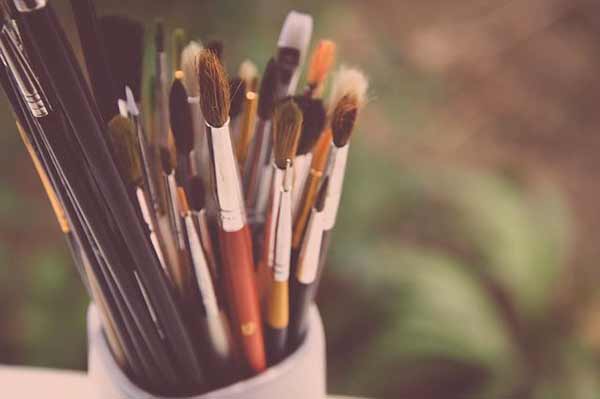Painting for Beginners: Learn How to Paint Like a Pro
Being able to capture that idyllic setting sun is a dream of many. But where do you start? What should you buy? How do you make your sunset look the way it should?
Like any hobby or craft, painting for beginners is full of pitfalls and possibly big dollar signs. But it's certainly full of fun, expression, and exploration.
To get you started, we've compiled an array of must-have gear and essential tips that are sure to make you the envy of every da Vinci wannabe out there. So whether you're more finger painter than Bob Ross, you'll be on your way to touching up sunflowers in no time.
The Right Brush for the Right Touch
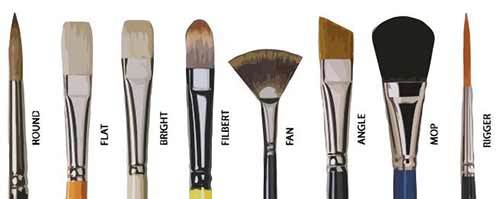
Grabbing the right brush for that perfect petal can be a hard lesson to master. Learning the right stroke is the first step in painting for beginners. However, picking the right brush type is like picking the right apple at an apple festival. Where do you begin? How much do you spend? What does quality look like?
Before you buy that expensive set, first learn the purpose of each brush. Here are nine basic brushes for beginners:
Fan Paint Brush
The fan, as the name implies has bristles that are flattened and spread out, which help spread and blend the paint.
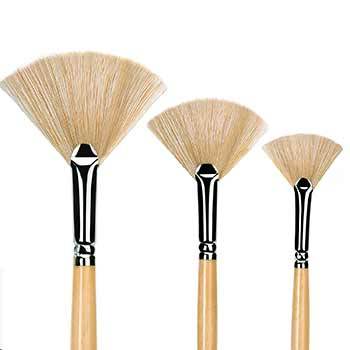
It also helps to create leaves on distant trees and develop textures like those in paintings with clouds and water.
Flat Paint Brush
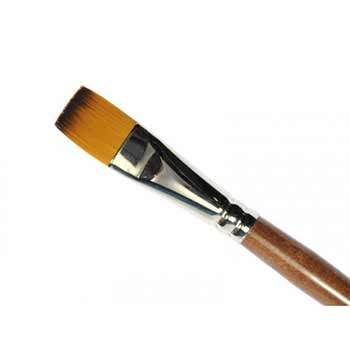
The flat brush has a flat tip with slightly rounded edges. It applies thick and strong colored paints in well-controlled strokes. It's not for the faint of heart nor for fine detail. However, it gets beginners building those mountains in no time.
Mop paint brush
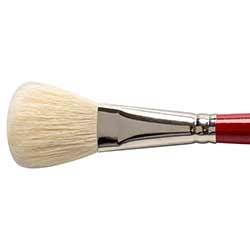
The mop is similar to the natural flat but has a rounded top. It helps to form circles, ovals, and curves, drawing out the paint.
Angular paint brush
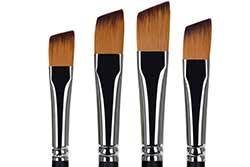
The angular brush, or flat angle, is shaped as if the flat brush decided to get a hip haircut. It helps to get into corners and edges and also forms curves well.
Filbert Paint Brush
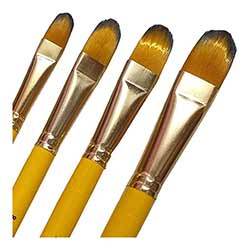
If the angular brush tried to get a hip haircut, the filbert is a few weeks past needing a hair cut. Shaped like the flat but with a slightly rounded head, the filbert adds body to the stroke. Though unlike the flat, the leading edge of the filbert is softer and curved.
Shader Paint Brush
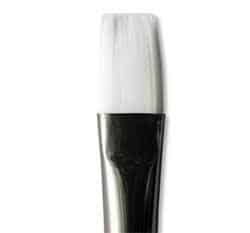
As the name suggests, the shader helps shade in edges and colors. It functions like a flat or angled brush, but its tip blends colors better.
Round Paint Brush

Round brushes are used for many things such as detailing, edging, fine work and broad strokes. also, the way you press and turn the brush as you draw your stroke will give you different results
Round tip Paint Brush
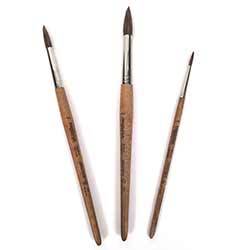
Round pointer brushes resemble round brushes but are finer tipped. They give you more detail for finer work.
Fine Line Paint Brush or Detail
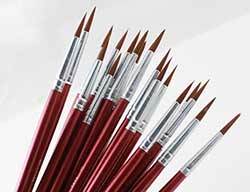
The last brush to consider is the detail brush. As the name suggests, it's for the finest detail possible, as in the mane on a stallion's neck or a feather floating in midair. It's not the best brush to use when painting for beginners, but it's essential as your talents develop.
What Are They Made Of?
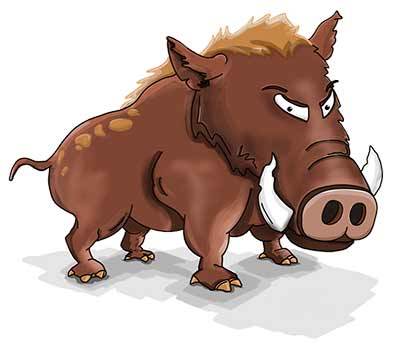
A quick note on the material used in the brush. Brushes have come a long way from the Renaissance and even early American painting. For example, the early American painter, Benjamin West, cut the hair off of his cat to make his paint brushes. He later would upgrade to camel hair brushes.
Natural Material
Natural brushes still are used today. In fact, many experienced artists suggest they are the only way to paint. They are made of boar, camel or sable hair and are more expensive than synthetic hair, but many suggest they hold paint better.
Synthetic Fibers
Synthetic, fibered brushes usually are made from nylon, polyester or a combination. They are cheaper, and there aren't ethical issues associated with them.
They are a good start to painting for beginners though you may want to upgrade as you progress.
Paint by Any Other Name… Is Still Paint Right?

There are three basic types of paint to use when painting for beginners: watercolor, acrylic, and oil. They all have their own pros, cons and specific uses. Ultimately, there is no right and wrong here, just considerations.
Watercolor
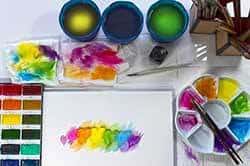
Watercolor is probably the most ubiquitous painting style. Real watercolor is significantly more robust than the kits you get from the box store, and pricing can vary from a few dollars a kit to several tens of dollars a tube depending on your desire.
Consider these pros and cons when selecting watercolor:
Pros
Cos
Acrylic
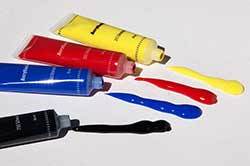
Acrylic paint is another great starting point when beginning for painters. It is water soluble, fairly inexpensive, dries quickly and doesn't bleed like watercolors.
Acrylic paint is a form of plastic polymer and usually is found in paste form. It can be more fluid depending upon the brand, and because of its thickness, we recommend using harder bristle brushes to apply it.
Pros
Cos
Oil Paint
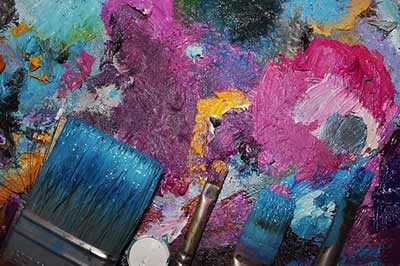
Using oil paint is challenging when painting for beginners. Oil paint is made from mixing pigment with either linseed oil or walnut oil. It's oil based, so it doesn't dry as fast as watercolor or acrylic, leaving more time to adjust the color, texture, and stroke. Oil paint does require the use of paint thinner.
Pros
Cos
Before You Buy the Whole Enchilada
Regardless of which paint you use, it's very tempting to buy the largest set of paints you can find. However, a useful tip when painting for beginners is to buy just a few basic colors.
Remember you can always mix them, so start with primary colors, a white, a black and maybe a brown and mix away. It'll save you big $$$ and will keep you from getting overwhelmed.
What a Mess!
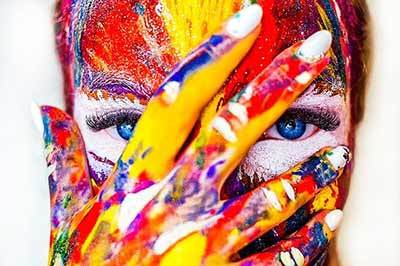
Famous TV host and Painter Bob Ross was fond of saying, "We don't make mistakes, just happy little accidents."
While in one sense this is true, wearing your best pair of Calvin Klein's while making that happy little accident can turn a smile upside down.
Messes happen while painting; it's important to prepare for it.
Second Best
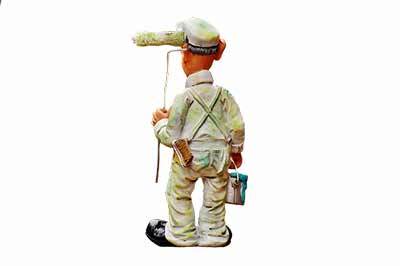
While it's obvious, we shouldn't wear our Sunday best while painting, avoiding our Monday best is also a good idea. Wear clothes you're comfortable dirtying
Smock It Up
While it's important to have texture on your painting, having layers on your pants is no bueno.
A smock is Batman's cape of the painting world. It acts as the first line of defense while painting your masterpiece. It's also highly attractive, almost as much as socks and sandals.
Gloves?
Gloves aren't a necessity and may even hamper painting for beginners, but it can be beneficial when working with oils. Some people can have adverse reactions to the paint and pigment used.
And frankly, the clean up is no picnic either. The oil thinner or turpentine is toxic and flammable. Gloves can reduce the mess and clean up. Just know ahead of time if you're allergic to latex. If so, try nitrile gloves.
Don't Draw on the Wall

Technically, you can paint on regular paper, the wall or your sibling for that matter, but having the right medium on which to paint is essential for optimal results. Whatever medium you chose (assuming it's meant for paint) can vary in style and cost from simple watercolor paper to high-end canvas.
Painting for beginners shouldn't break the bank. In most cases, you'll need to prime the medium before you start (we'll discuss that further down), but even that's an important exercise of painting for beginners.
One thing to consider when purchasing a medium is: Does it support the designated paint type? Read the descriptions or get recommendations from your art supplier before you start.
Hey Take It Easel
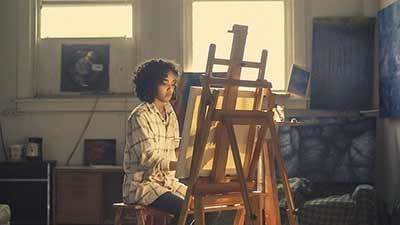
Easels are an important part of painting, but large easels aren't essential for painting for beginners.
Case in point, in the video below, the artist and educator, Shoo Raynor, spends time taping his watercolor paper to his stand. His stand acts as an easel, and even that is unnecessary.
Even though easels are not essential, they do make the life of painting for beginners easier and certainly more portable. The tri-legged easel is the most common due to its stability and its functionality. It can be used outside or in a studio, and because of its long legs, does not need an additional prop. However, it is bulky and not always conducive to painting on the go.
You can use a studio-style easel. It is significantly more portable than the traditional easel. Some even have built-in trays. However, they do require something to rest on, like a table. This may limit its use in the field. And while it is possible to lay it on your lap, or your friends back, neither produce a stable platform to rest upon.
Pallet of Palettes
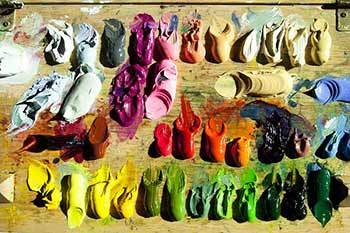
Having some an area to mix your paints is a must-have item for beginners. What we usually have in mind is that curved wooden palette with a hole in it for our thumb. It is the quintessential artist's palette.
However, there are others:
You do not need to have a palette per se, but you do need something on which to mix the paint. British artist and educator, Margaux Valengin, suggests even using a scrap piece of glass for an oil painting palette. She recommends taping the edges with duct tape to protect yourself.
It may not be significantly en vogue, but it will save you a bit of cash and is a helpful painting for beginners tip.
Tips of the Brush
Just like any new venture, there is a learning curve associated with painting for beginners. But now that the basic gear is out of the way, let us consider a few tips and pitfalls to avoid.
Because the last thing you want to do is spend several hours on that masterpiece only for it to be ruined because you forgot an important first step.
Cash In on Being Part of the Club
Everyone wants to be part of a club, just consider the members only jackets fad for a second. However, painting for beginners can come with some unknown perks.
Often art suppliers will give out paint supplies for free. Obviously, it is not an everyday occurrence, but it does happen. Going to a craft show, gallery expo or a supply store are great ways to score some loot.
Most often these will be small sample sizes, but since you're just starting, it can be a great asset. Painting for beginners doesn't have to be expensive, but you have to be willing to ask questions. As an additional perk, you may score a few new tips and maybe a new favorite brand.
Get a Feel for the Joint
Get a feel for the type of paint you are using. There are tips and tricks for everything. A little experimenting and a little research can make your skill level explode.
For example, having a hair dryer handy when using watercolors shortens the time between layers of paint. A few seconds of hot air and you can add a new hue.
Sometimes oil paint can feel dry to the touch, but it's only the surface; the deeper paint may still be wet. This can lead to smears when handling the painting.
Learn the tips and hacks for the medium you plan to use.
Prime the Pump
Many canvases today already are primed. This can be a great purchase when painting for beginners. However, it is more expensive to buy pre-primed canvases and paper.
Alternatively, you can prime your own canvases or paper. The simplest way to do it is by buying a pre-made primer. For example, acrylic gesso is a primer for acrylic paint.
It's essentially a watered-down version of acrylic paint though, more traditionally, it is made from rabbit skin glue that's applied to the canvas before actual painting begins. It stiffens the canvas and adds texture to it as well. But it prevents the actual paint from bleeding through, thus preserving the paint.
Typical gesso is white, but you can find it in a number of different colors as well as clear. Once you get a handle on priming a canvas, you can make your own primer. This is definitely a level up move and not necessarily a method of painting for beginners, but it'll save you money in the long run.
Hey, My Eyes Are Up Here!
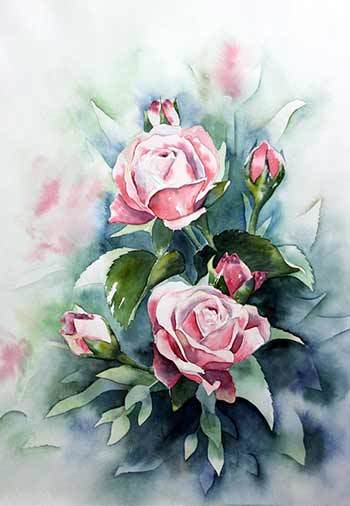
A mantra often heard when growing up was 'Focus, hey, focus!' It's an important part of painting for beginners as well. Just not in the attention span way. Be sure that the focal point of the painting is what you intended it to be.
You wanted to paint that Edenic garden scene at sunrise, but everyone else's eyes are attracted to the fence post in the foreground. Determine what the focal point of the piece is going to be and then build around it.
Don't spend a lot of time or color on the peripheral details as they may become distracting to a future viewer.
Keep It in Your Circle
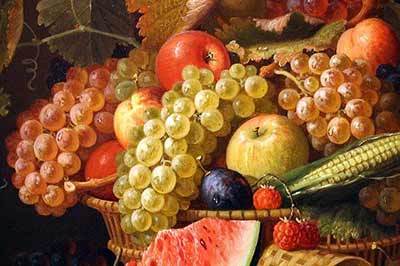
An important skill to hone when painting for beginners is controlling your domain. Be comfortable at your workstation and make it work for you.
A focal point of ergonomic design is to have the most used and the most important objects closest to you. Spreading out material too far can become a hassle and make it harder on you. Slight adjustments can have a world of payoff and make painting more enjoyable.
Each painter will have their own way of laying out their studio, but there are a few things to consider. First, for smaller objects, place them only a few feet away. This allows you to see details and prevents eye strain.
Also, putting the object on the opposite side of your dominate painting hand ensures you can see the subject at all times. Your arm, no matter how petite, does not make for a good window.
For inspiration, take a look at how New Zealander artist, Andrew Tischler, sets up his studio.
Patrol Your Palette
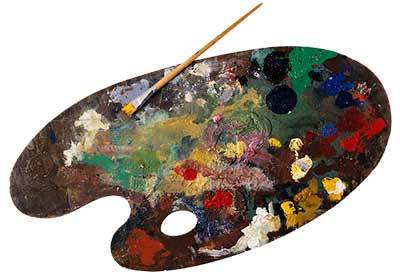
Managing your palette is much like a coach managing the clock in the big game. Late in the fourth quarter and down by a few points, the last thing you want to be short on is timeouts.
Likewise, no matter how big your palette is there is only so much space. Mind how much space you use to mix paints. As you load your brush, be careful to keep the paint contained to a minimal area.
The last thing you want to do is stop painting midway and clean your palette. Paints, especially like watercolors and acrylics, may dry during the cleanup time, preventing you from altering or adding to them as you intended.
Patrolling your palette is a great skill to learn when painting for beginners and will translate to better efficiency while painting in the years to come.
Paint with All the Colors of the Wind
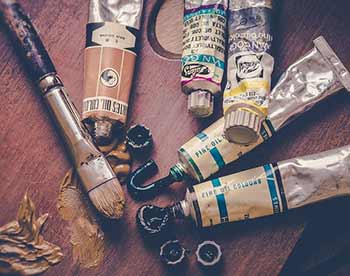
As you are busy patrolling your palette, it'll be incumbent upon you to know your colors. More importantly, know how to get those colors. You will not have enough space or money to own all the colors in the visible spectrum. However, you can make all of these colors.
Starting out with the primary colors red, blue and yellow, as well as black and white, will get you the colors you need. That being said, having a few more basic colors will make life easier.
Owning a color wheel, and knowing how to use it, will save you long hours of trial and error. One more word from the wise when mixing colors, mixing too many colors together will definitely get you a color.
That color just happens to be brown. Once you've got brown, you stay with brown. Take your time. Have a plan to get the color you want. Mix well and, if it hasn't been said yet, take your time.
Are You Sure You Have Enough?
Speaking of mixing those colors. Are you sure you mixed enough? Sure there might be enough for that first spruce tree, but what about the fourth?
It can be a balancing act between not having enough and patrolling the palette. However, having a little mixed color left of over is better than the alternative.
It is impossible to mix the exact shade of paint a second time, especially painting for beginners. Unless you are supremely skilled at transitioning colors seamlessly, trying to mix the perfect color again can be a challenge. Just don't go overboard.
Fade to Black
When building out a painting or experimenting with the right color start with lighter colors and build up from there. It's not that it's difficult to go from dark to light, it's that it's almost impossible - especially when using watercolor.
Darker colors cover. Plain and simple. If you start with darker colors and then try to lighten them, it can take several layers—if you can rescue it at all.
Instead, start with a color a few shades lighter than perhaps you think you want and see what you think. This technique also works for building up backgrounds and light.
Clouds, water, shadows, and light all require lighter and darker shades. Adding the darker colors as you progress makes life as a painter easier.
Saving Painting Ryan
Saving paint is another important skill that should come early when painting for beginners. Paint doesn't grow on trees, well in a way, but paint isn't free, so the more you can do to save your paint the less you'll put out per month.
How you save paint will depend on the type of paint you have. Acrylic paint usually comes with lids and should be sealed well between uses. Try to get palettes with lids for watercolors to prevent drying out. Oil paints can be kept in the freezer between sessions to preserve them.
Small efforts here and there will keep your paints viable for much longer.
Potatoes and Paintings
Storing your paints and paintings while working can sometimes be necessary. How you store them though is important. Unfiltered light degrades paint.
So does too much moisture. Dust also can be a problem, especially when the paint is still drying. While you want texture, unwanted fuzz balls are not quite what Picasso had in mind.
In between painting sessions, store your work in a cool, dark room free of dust. When showcasing pictures, try to use artificial light for paintings.
Practice Makes Progress
There is no perfect painter. The famous poet, Ralph Waldo Emerson, said, "Every artist was once an amateur." It takes practice. Trying new techniques. Painting that vase of roses one more time to master a skill. Practice doesn't make perfect when it comes to art; it makes progress.
Developing your skills over time is what it's all about. Painting for beginners is about the journey, the growth, the experience. It's a ride, though slow at times, which is meant to be enjoyed and shared.

